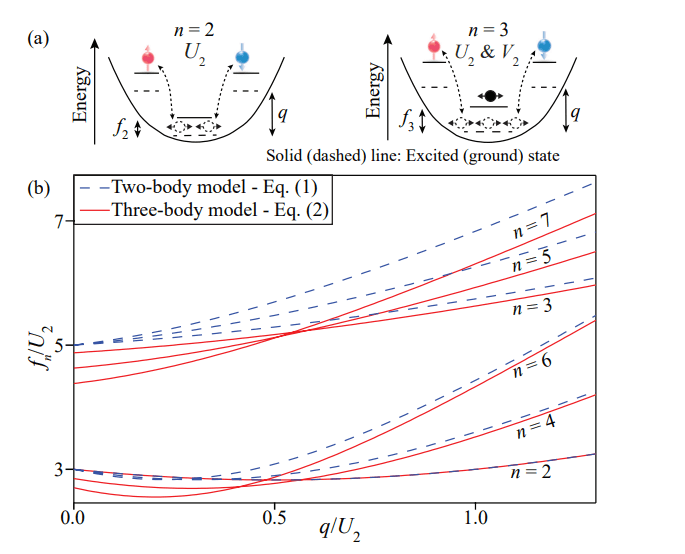The subtle influence of three-body interactions, often hidden by more dominant two-body effects, now comes into focus thanks to new research led by C. Binegar, J. O. Austin-Harris, and S. E. Begg, alongside colleagues including P. Sigdel, T. Bilitewski, and Y. Liu. The team experimentally detects these coherent three-body interactions by observing the behaviour of ultracold atoms trapped within a lattice of light, and then rapidly changing the conditions to induce a dynamic response. This work reveals how crucial these interactions are for accurately predicting the distribution of atoms in lattice systems, with implications for understanding the formation of spin singlets and other strongly-interacting quantum phenomena. The techniques developed promise a pathway to investigate even more complex interactions involving multiple atoms, broadening our understanding of these fundamental quantum systems.
Pin dynamics induced by controllably quenching lattice-confined spinor gases are investigated. Three-body interactions are characterised through both real-time and frequency domain analyses of the observed dynamics. The results, well-described by an extended Bose-Hubbard model, further demonstrate the importance of three-body interactions for correctly determining atom distributions in lattice systems, which has applications in quantum sensing via spin singlets. The techniques demonstrated in this work can be directly applied to other atomic species, offering a promising avenue for future studies of higher-body interactions with broad relevance to strongly-interacting quantum systems.
Lattice Quench Dynamics in Bose-Einstein Condensates
This document provides extensive supporting information for research investigating the dynamics of spin-dependent interactions in a lattice-confined Bose-Einstein condensate following a quantum quench. It justifies the methods used to analyse experimental data, presents detailed results beyond the scope of the main paper, and enhances reproducibility for other researchers. The document is well-structured and represents a strong example of supplemental material. The research details the mathematical description of how the quantum state evolves after the quench, using an eigenmode expansion to understand the origin of observed oscillations.
It explains how physical observables, such as the population of different spin states, are calculated from the quantum state. Crucially, the document emphasizes the use of the Fourier transform to extract oscillation frequencies from time-dependent signals, identifying relevant energy scales and interactions. The analysis highlights the importance of considering interactions between multiple particles to accurately describe the dynamics of the Bose-Einstein condensate. Quantum quenches prove to be a valuable tool for probing interactions and properties of the condensate. The document provides a wealth of detail, is easy to follow, and enables reproducibility. It demonstrates transparency regarding assumptions and limitations, and features strong visuals.
Three-Body Interactions Observed in Ultracold Gases
Scientists have achieved the experimental detection of coherent three-body interactions within ultracold atomic gases, a feat previously obscured by stronger two-body effects. The research team induced these interactions through carefully controlled quantum quenches of lattice-confined spinor gases, allowing them to observe and characterise the subtle influence of three-body interactions on the system’s dynamics. Experiments reveal that these interactions significantly impact the distribution of atoms within the lattice, demonstrating a crucial role in accurately describing the behavior of strongly-interacting quantum systems. The team induced these interactions by initiating nonequilibrium spin dynamics within the atomic gas through sudden changes to either the lattice depth or the magnetic field.
Analysis of the resulting dynamics, specifically through frequency domain analysis of the observed oscillations, allowed for precise probing of the atom number and spatial distributions within the three-dimensional lattice. Results demonstrate that the observed frequency shifts are accurately predicted by an extended Bose-Hubbard model incorporating three-body interaction terms, confirming the importance of these interactions in dense lattice systems. Measurements confirm that three-body interactions manifest as distinct signatures in the spin populations, appearing as multiple Rabi-type oscillations during the evolution of the system. The team’s model accurately predicts these oscillations, demonstrating the validity of the extended Bose-Hubbard model in describing the complex interplay between two-body and three-body interactions. This breakthrough delivers a new level of control and understanding of many-body quantum systems, with potential applications in quantum sensing and the exploration of higher-body interactions.
Three-Body Interactions in Lattice Gases Quantified
This research successfully demonstrates the experimental detection and characterisation of coherent three-body interactions within lattice-confined spinor gases. By employing a quantum quench method and analysing the resulting non-equilibrium spin dynamics, scientists precisely quantified the strength of these interactions through both real-time observation and frequency domain analysis. The findings reveal that accurately modelling these three-body interactions is crucial for determining the distribution of atoms within the lattice structure, improving the precision of existing models. The team’s work extends beyond simply identifying these interactions; it establishes a technique for accurately determining atom number distributions in lattice systems, a fundamental step towards controlling singlet states with potential applications in quantum memories and quantum metrology. While the current study focuses on sodium atoms, the demonstrated techniques are readily applicable to other atomic species, opening avenues for broader investigations into many-body interactions.

